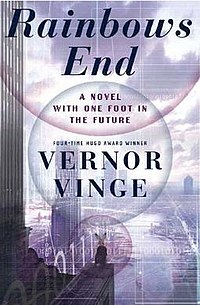Rainbows End
by Vernor Vinge
Thanks to advances in medical technology, Robert Gu is slowly recovering from Alzheimer's disease. As his faculties return, Robert (who has always been technophobic) must adapt to a different world, where almost every object is networked and mediated-reality technology is commonplace. Robert, formerly a world-renowned poet but with a notoriously mean-spirited personality, must also learn how to change and how to rebuild relationships with his estranged family. At the same time, Robert and his granddaughter Miri are drawn into a complex plot involving a traitorous intelligence officer, an intellect of frightening (and possibly superhuman) competence hiding behind an avatar of an anthropomorphic rabbit, and ominous new mind control technology with profound implications.
Augmented reality
In the novel, augmented reality is dominant, with humans interacting with virtual overlays of reality almost all of the time. This is accomplished by wearing smart clothing providing gesture recognition and contact lenses that can overlay and replace what the eye would normally see with computer graphics, using advanced virtual retinal display (VRD) technology. In addition, haptic feedback is possible by overlaying graphics onto a physical machine such as a robot. This augmentation of reality is used for a variety of purposes: * Commercial (large gaming areas sell gaming environments mixed with haptics). The Cheapnet, a free entry-level service offered by commercial vendors of gaming solutions, can in principle also be used to coordinate networked augmented reality representations across the globe. However, jitter and latency are considerable problems with this basic network when long distances are involved. In the novel, Robert Gu develops an algorithm that partially compensates for these technical deficiencies, and might ultimately allow the inclusion of haptics.
* Functional (maintenance workers, for example, have access to a blueprint or schematic of practically any location or object in their responsibility area) * Communication (characters in the novel use live video chat and can send and receive "silent messages", an action known as "sming", through their VRDs). Individuals can be reached through a globally implemented unique personal identifier, the ENUM. * Medical (doctors have access to a patient's vital signs) There are characters who choose not to "wear" these virtual overlays, instead using laptops, considered relics in the novel. A user's skill in managing and producing augmented reality manifests itself in the details of the augmentation. For example, a character might project himself into a different room, but the shadows cast by this apparition, or the collision between the character and the furniture in the room might give away the apparition.Belief circles
There are many realities to choose from in the novel; however, the largest and more robust of them are built by large user bases in the manner of a wiki or Second Life. The confederation of users that contribute to the virtual world is called a belief circle. Several belief circles are presented in the novel, including worlds based on authors such as Egan Soccer set piece can also be seen as a type of subscribed Belief Circle.
